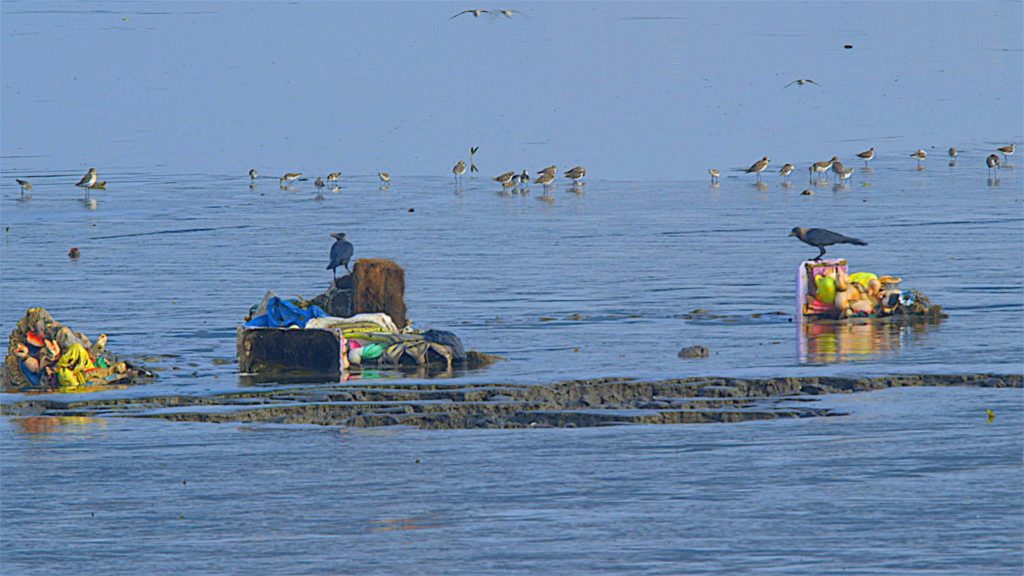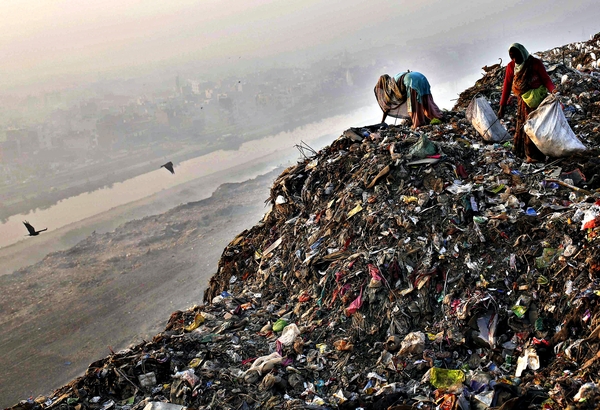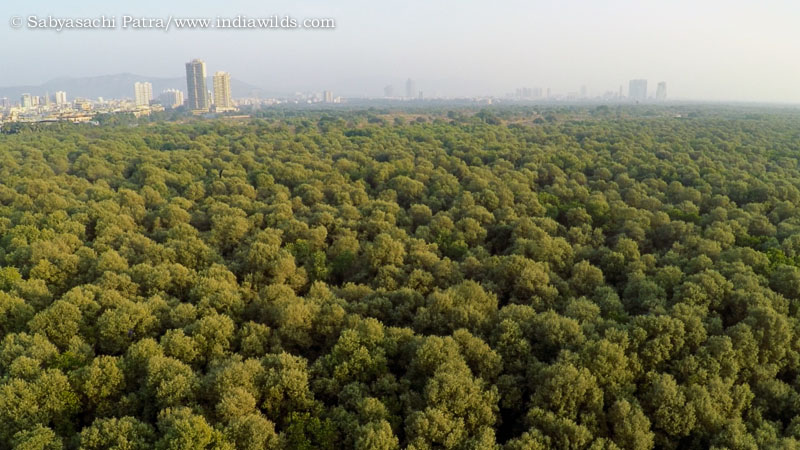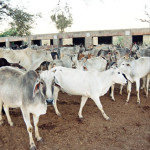IndiaWilds Newsletter Vol. 9 Issue IX
Religious tenets, Rituals & State of the Environment:

Indiawilds Newsletter Cover Page -September 2017
It is said that Faith can move Mountains. Today irresponsible manner of channelizing our faith has resulted in environmental problems of gigantic proportions and the mountain of environmental problems is becoming too difficult to overcome.
Festivals & Environment Pollution:
India is now in the grip of the festival season. To be frank, we have a festival in every month and in fact we even have festivals few weeks apart through out the year. Now we have the Durga Puja which is celebrated in much fanfare in Eastern India as well as Mysore, Delhi and sporadically in other parts of India as well. At the same time, in the North India we have the Navratri and in a few days we will have the Laxmi Puja and Dipawali. We also have the Muharram and there would be a few other festivals during this time of the year, as India is home to practitioners of many religions.
Durga Puja is celebrated with much pomp and show. If you are in Odisha or West Bengal or in Parts of Bihar, you would find a public Durga Puja in every lane and at times in every kilometer. There was a time when the “puja pandals” as they are called, used to literally face each other. With the skyrocketing costs, the number of such Pujas have come down, nevertheless there are still significant number of public pujas. The size and height of the idols are enormous and the constructions start a few months ahead.
There was a time when the sculptors used to painstakingly make the idols using straw and mud and a bamboo frame supporting the structure from behind. Once the construction was over, paint produced from organic material were used. Unfortunately, these days the traditional knowhow for making paint has virtually vanished. The ease of use of synthetic paints has ensured that people use them. The mud and straw frame has now been replaced by plaster of paris (POP) as the idols made with PoP are more durable and doesn’t break during transportation. Unfortunately, this strength is also the weakness of PoP. The PoP idols doesn’t disintegrate easily and are not biodegradable. The PoP idols create an environmental hazard. If the PoP idols are to be immersed in nearby pools, then the water becomes toxic for the animals who drink the water as well as for the aquatic species like fishes who die a painful death due to lack of oxygen.
Bal Gangadhar Tilak was impressed by the way the common men and women bonded during Durga Puja celebrations in Bengal, and started Ganesha worship in Maharashtra in 1893 to increase cultural and social cohesion. He would have never imagined that India’s population would grow to a humongous 130 crores and millions of idols will get immersed in lakes and rivers and the sea. And with the immersion of the millions of Idols, we are creating environmental problems of epic proportions, which were not envisaged in those days.

Crows on Non biodegradable idols of Lord Ganesha
Last month we had thousands of Ganesha idols floating in various rivers, ponds, sea and ocean. The chemicals used in these idols cover the water like a tar coating. In Mumbai, for two days, I couldn’t site mudskippers and crabs as the coast and mud flats were completely covered with the dark brown coating. The chemical coatings also leach into the ground and pollute the ground water.
Every year we get reports of fishes dying and floating after many idols are immersed in the ponds and rivers. Recently newspapers had splashed photos of Ganesh idols lying in Yamuna river, whose waters are blackened due to the discharge of industrial effluents. The idols made of plaster of paris didn’t disintegrate for number of days. The half broken idols in the Yamuna were a sad sight. Surely, our Gods would not be happy lying unattended.
What kind of religious belief is this that we are ready to poison our water and the earth?
Importance of Water According to Rig Veda:
According to Rig Veda (19th Mantra of 23rd Sukta of 1st Mandala),
“Apsu antah amrutam,
apsu bhaisajam,
apamuta prashastaye,
deva bhabat bajinah”
which loosely translated means “Immortality is the middle of waters, the healing powers are in the waters, O Gods, become full of plenitude (so that) the Waters become praiseworthy”.
An adult Human body has at least 50% water content. Civilisations are known to have reached their peak on the banks of rivers and have perished due to lack of water. According to world bank report, India’s economy can be derailed due to insufficiency of water. Today even children are taught in the schools that there are water wars frequently erupting between states like Karnataka and Tamil Nadu. So the importance of water is well known to people. Despite this, it is surprising that we don’t take care of our water bodies.
According to Pandit Jawaharlal Nehru, Rig Veda is the finest creation of human mind. It is believed that Rig Veda mantras were given to sages during their meditation and the sages were just compilers of the mantras. Whichever way one believes, apart from being the Oldest Indo-European literature, Rig Veda is also one of the most sacred texts with hymns full of praise of the glories of Gods and their ways and offerings to them etc. So when the sacred Rig Veda espouses the benefits of water, it is indeed stupid of us to desecrate our water bodies on the pretext of celebrating various religious festivals.
Reclaiming Past Glory:
At the moment, the general refrain of the voting majority in India is that we should try to reclaim our past glory. There is a strident demand to wear the religion in our sleeves. Unfortunately, we are using and throwing religion to further only our narrow ends. Any layman can understand that our religion tells us to respect our rivers. Rivers are given names and treated as Gods. So we can’t be desecrating our river Gods by immersing non-biodegradable idols of other Gods. Unfortunately, we have forgotten spirituality and are only using religion as a means to show off our wealth and indulge in consumerism. If we can resolve this strange dichotomy of posing overtly religious and bashing up people in the name of religion while at the same time desecrating our river Gods, then India can be a better place indeed.
Neither we understand the religious and cultural ethos of this ancient land, nor do we act as per the current scientific norms. We have been blaming the west for most of the ills afflicting our society. The contemporary narrative is that we had a glorious past and hence we should turn the clock and recreate the great era where India was the land people used to flock to from far away lands. If we look at any glorious period in history, the common denominator is that people used to live a healthy, peaceful and prosperous life. So wfe have to first focus on giving people the basic necessities of life.
Pure Air, Water & Land:
Without pure air to breathe and pure water to drink we can’t survive. So first we need to give the people fresh air to breath in, pure water to drink and wash not only through the taps but pure water in ponds, lakes, rivers as well as pure groundwater. People should also be free to go to any place without the fear of being contaminated due to toxicity. This means protection of our environment, forests, air, water and our lands.
Unfortunately, in the mad race for so-called development, we have destroyed our environment and forests and have created mountains of toxic trash.
Trash Mountain & Trashslides:
Recently during the rains in Delhi, trash piles in Ghazipur landfill crashed and people died. The Ghazipur landfill spreading over 70 acres has been in operation since 1984 and had filled up to its capacity a decade and half ago. However, it still receives the trash from Delhi. On 2nd of September 2017, the landfill, which was as tall as a 15 storey building, crashed and swept away people in the nearby road and two people were reported to have died. We knew about landslides. The word trashslides was not coined before.

Trash Mountain Courtesy – online media
Last year in February and in April 2016 the Deonar dumping grounds of Mumbai caught fire and made life miserable. When fire starts in the Deonar dumping grounds spread over 326 acres, it is a massive conflagration and people from nearby areas had to flee to safety. Some 70 schools in the nearby areas had to be closed. However, it is not just Delhi or Mumbai or India which is inundated with trash.
Similar trash related disasters have occurred in other parts of the world. Trashslides have occurred in Colombo, Srilanka in April 2017 killing 11 people; in Addis Ababa, Ethiopia in March 2017 killing 65 people and in Manila in July 2010 killing 265 people. So India in infamous company of countries like Ethiopia, Sri Lanka and Manila is not a very good testament to our status as an emerging world power.
Waste, Xenoestrogen & Cancer:
It is also not just a question of people drowning in plastic, electronic and other household wastes. A North Carolina State University research study in 2015 found that synthetic and natural hormones called xenoestrogens released from plastics, pesticides and common prescription drugs are causing male fish to lay eggs. If it were to be just limited to fish, then many would not have got alarmed.
In most of the cases, the prescription medicines are dumped into the trash after their expiry. These leach into the ground and pollute the water. Most municipal water treatment systems don’t have the ability to neutralize pharmaceutical compounds in wastewater so they end up in rivers and streams and then it reaches us and get stored in our body fat. Human bodies have natural estrogen production, their quantities are regulated. However, when the Xenoestrogens enter the human bodies they start creating different problems in men and women. With increase of xenoestrogens in male bodies, there are many urban men with developed man-breasts. In case of women this increases the risk of breast cancer. So throwing away our waste without proper disposal is hitting us badly.
Our accumulated sins inform of years of nature and environmental abuse is now coming to haunt us. If we don’t accept these as signs of impending environmental catastrophe and take steps to avert it, then the human race may not emerge unscathed.
The wise men and women of ancient India understood the importance of nature and wildlife and had weaved the protection of our nature and wildlife into the religion. So most of the animals, birds, reptiles etc are depicted as vehicle or vaahana of various Gods and Goddess. So Lakshmi has the elephant and even owl, Vishnu is resting on a serpent and has Garuda as vaahana, Shiva has a snake coiled around his neck and a bull is associated with him, Kartikeya with peacock, Durga with lion etc. The river Ganga is said to have come from heaven due to the deep meditation of Bhagiratha.
The ancients had understood the importance of nature, wildlife and environment. Similarly the Jains, Buddhists and Parsees have environmental protection linked to their religion. Religion per se is not bad. Its improper and intentional misrepresentation to further narrow ends results in problems. Unfortunately, man since time immemorial has used religion to further his narrow designs.
It is time we the modern scientific generation instead of blindly following superstitions and rituals start questioning those and implement only the essence of the religious thoughts to improve our nature, wildlife and environment as the well being of mankind is intricately linked with the wellbeing of the earth as well as wellbeing of other species living on earth. Unless we do rapid course correction, the life on earth is going to nosedive at a rapid rate. We hope sanity prevails.
Conservation News:
Maharashtra Government creates Mangrove Protection & Employment Generation Scheme:
The Fadnavis Government in Maharashtra has now given its stamp of approval to the Mangrove Protection and Employment Generation Scheme and has allocated Rs. 15 crores of funds towards it for the year 2017-2018.

Mangroves in Mumbai
Under this scheme employment opportunities will be provided to local people to protect mangroves in public and private lands. It is expected that this scheme will help save mangroves to the tune of 30,000 hectares. This scheme will be applicable in 50 villages in the coastal districts of Sindhudurg, Ratnagiri, Palghar, Thane and Raigad where mangroves are found. In the next financial years, 2018-19 and 2019-20, it would be scaled up to 75 villages.
The Government has decided that it would help fund activities like bee keeping, crab farming, fish farming and tourism in these areas. A group of people or individuals can avail of this Government scheme. For group scheme, the Government will invest to the tune of 90% and for individual beneficiaries 75% will be from the Government. The rest will have to be borne by the group and individuals respectively.
Since these success of the schemes are linked with the health of the mangroves, people have to ensure the survival of the mangroves. For eg. if the mangrove cover is not sufficient, then the bees will not have sufficient nectar from the flowering mangroves. Different species of mangroves flower at different periods of time. So rich species diversity of mangroves will lead to good honey collection on a continuous basis. If people understand this linkage between protection of the mangrove ecosystem and their earnings then they are more likely to take part in preserving the mangroves.
Once the schemes start showing results, more funds can be channelized from other Government schemes including development funds from districts, MPLAD etc. The PCCF Wildlife will head a state level coordination committee to oversee and smoothen the implementation challenges. We hope that the Government continues these schemes for a long time and doesn’t drop it after an year or two, else the saviours of mangroves may get demotivated.
NGT allows highway linking of Badrinath, Kedarnath, Gangotri and Yamunotri
The National Green Tribunal has disposed off a petition challenging the road widening work in the roads connecting chhota char dham ie Badrinath, Kedarnath, Gangotri and Yamunotri. The road widening is happening under the plan to link the four holy places which has a budgeted investment of twelve thousand crore rupees. The foundation stone for this project was laid in December 2016 by the Prime Minister.
The NGT was hearing a petition that the road widening work was violative of the Bhagirathi ESZ notification and the continuous blasting and dumping of debris in Ganga in NH-34 is against the law. However, the Border Roads Organisation and the Government of Uttarakhand assured the NGT that they were adhering to the law and are not dumping any debris in the river. And the BRO also said that this project is of strategic importance due to the proximity to the India-China border. So the BRO will take all precautions to ensure that the blasting doesn’t result in destabilising the mountain. On hearing this the NGT bench led by Justice Swatanter Kumar said “In view of the statement made, nothing survives in this application and the same is disposed of, without any order as to cost. We make it clear that in the event (of) violation of any law or breach of the statement as made before the Tribunal, the Applicant would have the right to approach the Tribunal, in accordance with law”.
It is not however clear as to how the BRO will understand if the blasting of the mountains is destabilising the mountain or not. It may be pertinent to mention that Himalaya is a comparatively young mountain range and according to geologists the Himalaya is even younger than the rivers Bhagirathi, Alakananda and Brahmaputra. So these rivers have cut across deep channels which developed hand-in-hand with the growth of the Himalaya. Since the middle Pleistocene, Himalaya has risen about 5000 feet. It hasn’t reached maturity and hence apart from being ecologically fragile the Himalaya is also structurally fragile. So blasting of these mountains to create roads and dams results in creating faults and weakening it. It appears that since this road building is said to be of strategic importance, the NGT preferred to take the submission of the BRO and the Government at face value.
222 wildlife killed in 30km stretch in Uttarakhand
An astonishing 222 wild animals have been killed in only eight months in a 30 km stretch in National Highway-74 between Dehradun and Haridwar. This stunning finding is the result of a WII study titled “The impacts of a national highway on wildlife in Haridwar forest division”.
One Himalayan Black bear, two leopards, 11 spotted deers and 19 Sambars were among the animals killed between September 2016 to April 2017. A tiger was also reported to have been killed in May 2016. It is to be noted that at times wild animals who are hit don’t die on the spot. The injured animals try to run to dense forested areas where they die and the carcass is often eaten by scavengers. So the mortality rate is often much higher than the projected numbers.

Uttarakhand roadkill
The WII study finds that a particular stretch of the NH between Gauri Shankar temple and Kotawali in Chidiapur finds the maximum number of road kills as the wildlife are moving in search of water. The animals come out of Rajaji and go to the river Ganga for water. The roadkills are the result of overspeeding in this stretch as there is neither speed limit checking by authorities nor any humps or speed breakers to lower the speed. In the earlier days, the lack of good roads and potholes used to ensure that people drive at a lower speed. However, these days roads passing through the forests are generally well maintained and this acts like a curse on the wildlife of the area.
Though there have been suggestions to construct flyovers in this stretch, it costs money and hence is never considered. Studies like this create an impact and then mostly are placed on the backburner because wildlife is the last priority for the National Highway authorities as well as the Government. When there are accidents near villages and people die, then the local people come out in large numbers and disrupt the traffic and make their protest count. So immediately the authorities plan for flyovers. However, the voice of the wildlife is not often heard by the authorities. We hope that the authorities wake up and take serious action to prevent loss of precious wildlife.
ESZ radius reduction from 10km to 100m completely arbitrary says Supreme Court
The Union Government’s decision to reduce the Eco-Sensitive Zone distance from 10km to 100 meter surprised the Hon’ble Supreme Court bench comprising justice M B Lokur and Deepak Gupta. The Hon’ble SC bench said that the decision of the MoEF&CC is a “complete arbitrary exercise of powers” which is capable of destroying our National Parks, Wildlife sanctuaries and other wilderness areas.
The Hon’ble SC bench was hearing a case challenging the environmental clearance given to an industrial unit located within the 10-kilometre radius of Dadar and Nagar Haveli Wildlife Sanctuary and were taken aback by this decision of the Ministry of Environment, Forests and Climate Change.
The bench said “It is extremely surprising that the 10-kms eco-sensitive zone has been reduced by the Ministry of Environment and Forest (MoEF) to 100 metres. Since an order of this nature is capable of destroying national parks and wildlife sanctuaries in the country, we would like to examine the validity of this reduction… Prima facie, it appears to us a complete arbitrary exercise of power by the Ministry of Environment and Forest”.
The SC bench questioned Additional Solicitor General A N S Nandkarni, who was appearing for the Centre, as to whether the Government wants to destroy wildlife, reserved forests, rivers and sanctuaries in the country.
“You (Centre) have to satisfy us on the point as to how you intend to protect the wildlife, environment. Has the concept of ‘protected areas’ become irrelevant now?”.
The Wildlife Board of India had in 2002 adopted the Wildlife Conservation Strategy under which it was stated that land falling within a 10-km radius of the boundaries of the National Parks/Wildlife Sanctuaries should be notified as Eco-Fragile Zone under provisions of the Environmental Protection Act.
The apex court had endorsed the stand of the Centre earmarking a 10 kilometre radius as buffer zone around national parks and wildlife sanctuaries.
However, after the Modi Government assumed power at the Centre, it has started reducing the buffer zone radius from 10 kms to 100m through several notifications.
The present Government is seen more concerned towards the real estate builders and industries including mining and have been accused of selectively altering the laws including the ESZ notifications to benefit various lobbies. The Government though is always quick to defend its actions by saying that it cannot stall development.
Mahesh Sharma Takes Charge as Minister of State Of Environment, Forest and Climate Change
Dr. Mahesh Sharma has taken charge as Minister of State in the Ministry of Environment, Forest and Climate Change. Dr. Harsh Vardhan is the Cabinet Minister in charge of the Ministry of Environment, Forest and Climate Change as well as Ministry of Earth Sciences, Scient and Technology.
Soon after assuming the charge, Dr. Mahesh Sharma said that this is an important and a challenging Ministry in today’s time, when the whole world is concerned about forest, environment and climate change. He added that there is a lot to be done in the field of environment, starting from cleanliness, to pollution of air and water. “With the guidance of Dr. Harsh Vardhan and under the able guidance of the Prime Minister, Shri Narendra Modi, we will be able to address the burning issues related to environment, pollution and forestry”, the Minister of State said.
Earlier, Dr. Mahesh Sharma called on the Union Minister of Environment, Forest and Climate Change, Dr. Harsh Vardhan, before assuming charge as Minister of State. Welcoming Dr. Mahesh Sharma to the Ministry, Dr. Harsh Vardhan said that together, they will work towards realising the Prime Minister’s dream of delivering a New India to 125 crore Indians by the year 2022. Dr. Harsh Vardhan expressed the hope that Dr. Sharma will prove to be an asset to the Ministry.
Environment Ministry Launches ‘Prakriti Khoj’ – An Environment Quiz on Teachers’ Day
The Environment Ministry has launched an environment awareness initiative, under which an online environmental quiz competition named “Prakriti Khoj” – an Environment Quiz to be conducted at the national level. The quiz was launched on September 5 on the occasion of Teachers’ Day.
This environmental quiz is hoped to be an ideal medium to reach out to young minds through a fun-filled interactive learning mode to trigger their sensitivity towards environment protection and conservation. This quiz, in a way, will provide a unique platform for students to measure their awareness level regarding environmental issues. It aims to motivate them towards effective participation in other major programmes related to conservation and protection of the environment and wildlife.
The objective of the quiz is to generate interest among school children about the science related to environment, the complex inter-relationships and the associated challenges. This will help in sensitizing the children/youth to issues related to environment and development and motivate children towards environment conservation-oriented lifestyles. It will trigger their sensitivity towards nature appreciation and conservation, leading to positive environmental actions at different levels.
The quiz is planned in two phases. For the first phase, it is envisaged that maximum number of children of schools under the National Green Corps (NGC) programme of the Ministry should get an opportunity to participate in this environmental quiz. NGC was initiated by Ministry in 2001-02 for creating environmental awareness among children by formulating “Eco-clubs” in schools across the country. There are around 1,00,000 Eco-clubs across the country, making it one of the largest conservation networks, wherein students are involved in various kind of activities such as cleanliness drives, carrying out waste segregation, composting using bio-degradable wastes, subsisting the concept of three R’s, viz, Reduce, Reuse and Recycle; Nukkad Nataks etc. Three age groups is planned to be covered in Phase-I which will be open only to Eco-clubs i.e. in the age-groups 8-12 years, 13-15 years and 16-18 years. After this, based on the feedback received from the participants, the second phase of the quiz will be open to students from all schools across the country in the year 2018.
The mode of quiz will be online through multiple choice questions and can be found at http://pkeq.nic.in/
Thematic areas like climate change, biodiversity, forest and wildlife, pollution, waste management, rivers and lakes, natural history, international conventions such as Convention on Biological Diversity, United Nations Framework Convention on Climate Change, United Nations Convention to Combat Desertification, Convention on International Trade in Endangered Species of Wild Fauna and Flora etc. have been chosen for the quiz. The students from Eco-clubs specially registered on the portal will be able to participate in the qualification round from September 18, 2017 onwards.
During the first phase, the Ministry of Environment, Forest and Climate Change, in cooperation with State nodal agencies of National Green Corps programme, which are State Pollution Control Boards (SPCBs), State Government Bodies within the Environment Departments, State Science Council will implement the quiz programme through online mode. Quiz will be organized in school premises under the supervision of Principals/Eco-club Coordinators. There will be cash prizes for the winners. All participants will receive an E-certificate of participation, duly signed by Union Minister of Environment, Forest and Climate Change.
Assam clears Over 2,350 ha encroached forest land in 1 year
The Forest Minister of Assam, Pramila Rani Brahma has said that a total of 2,350.224 hectares (ha) of forest land has been cleared of encroachment since the BJP government assumed power in the State. Government of Assam is committed to evict all encroachers from the forest land. Only the traditional forest dwellers and others allowed by the law to live in forests will not be evicted.
The biggest amount of evictions happened in Manas National Park where 1600 hectares of forest land has been clear of encroachments. Karimganj Forest Division with170.25 ha comes next. This is followed by Amchang Wildlife Sanctuary where150 ha of forestland was cleared of encroachments. Digboi Forest Division with100 hectares, Goalpara Forest Division with 95 hectares, South Nagaon Forest Division with 59 ha and Dhubri Forest Division with 58.48 ha were the other major evictions.
The places where lower number of hectares but significant evictions happened were: East Sonitpur Forest Division (30 ha), Burhachapori and Laokhowa wildlife sanctuaries (25 ha), Lakhimpur Forest Division (21.054 ha), Aie Valley Forest Division (12 ha), Doomdooma Forest Division (10 ha), Cachar Forest Division (7 ha), West Kamrup Forest Division (7 ha) and North Kamrup Forest Division with1.44 hectares.
The minister also said that though Amchang Wildlife Sanctuary has been cleared of150 hectares of forestland, the eviction drive was halted due to apprehension of law and order problems and said that the Govt. machinery is preparing to resume the eviction drive with enhanced logistics.
The Forest Minister also said that there is no Government policy of rehabilitating the encroachers who have been evicted. However, several legislators, including Ahmed and MI Haque Choudhury (AIUDF), called for a special policy by the government to rehabilitate the landless people who had settled on forest land. Unfortunately, if the Government gives in to the opposition demand and creates a policy to reward the encroachers with rehabilitation, then it will encourage more encroachments.
Aminul Islam of AIUDF made allegations that the Government is not taking a tough stand on the encroachment by resort owners and tea estate owners in Kaziranga and is only evicting the poor. The minister also agreed to the suggestion of immediately acting on the encroachments rather than allowing the situation to fester.
Dr. Harsh Vardhan admits that Many species are on verge of extinction
The law of the land must be upheld is a commonly held view and now that has been emphasised by the Hon’ble Minister for Environment, Forest and Climate Change, Dr. Harsh Vardhan who said that many species are on the verge of extinction and the law of the land must be upheld to stop wildlife crimes and stop the species from going extinct. The minister said that there is an urgent need to spread awareness and sensitize people to stop crimes against wildlife. The minister was addressing a seminar on ‘Role of security forces in combating wildlife crimes’.
Dr. Harsh Vardhan said that we human beings have to live in harmony with the natural world as many species are being added to the endangered list and are alarmingly close to extinction.
The minister also appreciated the Sashastra Seema Bal’s initiative of organising a seminar with sister agencies, NGOs and special dignitaries on Wildlife Crimes as it enhances inter-departmental co-ordination and in the process, crime against forests and wild animals will be checked. Dr. Harsh Vardhan assured the gathering that the recommendations made during the seminar will be examined by Ministry of Environment & Forests as Action Points for implementation.
Sashastra Seema Bal (SSB) has 629 Border Outposts (BOPs) out of which as many as 229 BOPs are located in the classified forested areas. Last year, the Sashastra Seema Bal had not only arrested 62 criminals in 60 cases, but had also saved the lives of Tokay- Lizard and sand-boa snakes. This year, in just 8 months, 85 cases have been registered, while 95 smugglers have been arrested. Apart from these, SSB confiscated body parts of endangered spices, dear, Turtles, rabbits, pigeons and elephant tusks.
Dr. Harsh Vardhan said that the job of Sashastra Seema Bal (SSB) is more difficult, since it guards the open borders with friendly neighbouring countries, where force alone cannot be used to enforce the law of the land. He pointed out that development activities have increased tremendously after India’s Independence and in this process, people destroyed the natural abode of wild animals by cutting down forest for agricultural and industrial use. The Minister added that tremendous loss has already been caused to environment and wild animals due to human mistakes. ‘Certain plants and wild animals either have either become extinct, or are on the verge of extinction, if whatever is now left with us is not taken care of, then in the coming days, we will see forests and wild animals only in books’, Dr. Harsh Vardhan said.
Equipment Discussions:
Sony Unveils Venice CineAlta Full Frame Motion Picture Camera
Sony has unveiled its first full frame cinema camera and has named it Venice. This is part of Sony’s CineAlta camera system.

Sony Venice Cinealta Camera
Salient Features:
This is the first time Sony is using a Full frame (36x24mm) sensor. However, one has to wait for a future firmware upgrade to shot 36mm 6k resolution shooting.
The aesthetics of Full frame camera is way different from the S-35 format. That is the reason why the filmmakers were so excited when Canon had included the ability to shoot full frame video in the 5D Mark II DSLR. One naturally gets shallow depth of field while shooting in full frame.
This camera has a PL mount which can be removed in the field by removing four bolts. There is an E mount underneath the PL mount, so that the E mount can be used when there is requirement for using lighter lenses. One can also shoot Super 35mm and anamorphic. Considering the rivalry between Canon and Sony, it is understandable that Sony doesn’t have a native EF mount like Arri Amira and others. So if someone wants to use the popular EF lenses then he/she has to use an EF mount to E mount adapter.
According to Sony, the sensor scanning is fast and helps in minimizing the Jello effects.
The Venice CineAlta camera has a new color management system with an ultra wide color gamut. It has more than 15 stops of latitude so that it can easily handle in the same frame low-light as well as harsh sunlight with a gentle roll-off handling of highlights.
VENICE uses 16-bit RAW/X-OCN via the AXS-R7 recorder, and 10 bit XAVC workflows. VENICE is made compatible with current accessories like DVF-EL200 Full HD OLED Viewfinder, AXS-R7 recorder, AXS-CR1 and high-speed Thunderbolt-enabled AXS-AR1 card reader, AXS and SxS memory card formats etc. Interestingly VENICE can simultaneously record RAW to AXS-R7 recorder and the Prores to internal Sxs memory cards.
Venice has the industry’s first built-in 8-stage glass ND filter system which is mechanical and servo-controlled. The ND filter wheels reduce exposure from clear to ND0.3, ND0.6, ND0.9, ND1.2, ND1.5, ND1.8, ND2.1 and ND2.4. According to Sony employing the ND filters results in no contamination of IR or any other spectrum of light.
Sony has created a license system whereby one can use the camera features like 4K anamorphic and full frame in a weekly and monthly licenses.
Press Release:
Sony Unveils Venice, its first 36x24mm Full-Frame Digital Motion Picture Camera System
LOS ANGELES, Sept. 6, 2017 — Sony Electronics is unveiling VENICE – its first Full-Frame digital motion picture camera system. VENICE is the next generation of Sony’s CineAlta camera systems, designed to expand the filmmaker’s creative freedom through immersive, large-format, Full Frame capture of filmic imagery producing natural skin tones, elegant highlight handling and wide dynamic range. VENICE was designed through close collaboration with the creative community, fulfilling the requirements from filmmakers and production professionals.
VENICE will be officially unveiled on Sept. 6, in front of a select audience of American Society of Cinematographers (ASC) members and a range of other industry professionals. Sony will also screen a short film, “The Dig”, the first footage shot with VENICE, produced in Anamorphic, written and directed by Joseph Kosinski and shot by Academy Award winning Cinematographer Claudio Miranda, ASC.
VENICE has a fully modular and intuitive design with refined functionality to support simple and efficient on-location operation. It is the film industry’s first camera with a built-in 8-stage glass ND filter system, making the shooting process efficient and streamlining camera setup. The camera is designed for easy operation with an intuitive control panel placed on the Assistant and Operator sides of the camera. A 24 V power supply input/output and LEMO connector allow use of many standard camera accessories, designed for use in harsh environments.
License options for individual production requirements
With VENICE, Sony is giving users the option to customize their camera by enabling the features needed, matched to their individual production requirements. Optional licenses will be available in permanent, monthly and weekly durations to expand the camera’s capabilities with new features including 4K anamorphic and Full Frame, each sold separately.
The VENICE CineAlta digital motion picture camera system is scheduled to be available in February 2018.
Canon Launches EF 85mm f1.4L IS USM lens
Canon has announced a slew of interesting lenses with a 85mm f1.4 L IS lens and three macro tilt-shift lenses. This is the first time Canon has announced a Tilt-Shift lens with macro capabilities.

EF85mm f1.4L IS USM lens
The 85mm f1.4L IS USM lens is an often used focal length for portraits. Though this lens is F1.4 and not f1.2, Canon has included Image stabilization making it more useful for a lot of applications.
I do have the wonderful 100mm f2.8 L IS macro lens, however, the 100mm focal length is a bit too long for certain applications and the 85mm f1.4L fits into those requirements nicely.
According to Canon the image stabilization in the EF85mm f1.4L IS USM lens is effective for four stops. So one can shoot in very low light, handheld and can get some lovely imagery if the subject is not moving.
Construction of the Lens:
The EF85mm f1.4 L IS USM lens uses one large diameter high-precision moulded glass aspherical lens. It also has an ASC coating. This diaphragm of this lens has 9 blades which helps in getting a nice rounded bokeh.
Availability: November 2017
Price: $1599 US dollars.
New Tilt-Shift Lenses from Canon
Canon has announced three new Tilt-Shift lenses. The tilt-shift lenses are much sought after lenses by photographers shooting architecture and for any application that requires perspective correction. In landscapes, when you are shooting tall trees with a wide angle lens the trees appear to converge at the top. This can be changed by working on the tilt function and the shift function helps in the depth of field control.
Canon has announced three new tilt-shift lenses – Canon TS-E 50mm f2.8 L Macro lens, TS-E 90mm f2.8 L Macro and TS-E 135mm f4 L Macro lens.

TSE50 f2.8-Macro Tiltshift
According to Canon, these new Tilt-Shift lenses have better optical elements like Aspherical and UD elements which results in edge-to-edge resolution, improved image quality over previous Canon TS-E lenses and minimum distortion. There are also two anti-reflective coatings, SubWaveLength Structure Coating (SWC) in the TS-E 50mm f/2.8L and TS-E 135mm f/4L Macro lenses and Air-Sphere Coating (ASC), into the TS-E 50mm f/2.8L and TS-E 90mm f/2.8L Macro lenses. SWC helps to reduce flare and ghosting, while ASC is a new technology that provides amazingly high, anti-reflective performance, particularly when alleviating incidental light that can enter a lens.
These new Tilt-Shift lenses have also larger tilt, shift-and-lock knobs, lock-release button and a new tilt-locking mechanism that firmly locks the lens in the zero-tilt position to help prevent unintended tilting to increase more precise shooting capabilities. The rotation of the tilt-shift lenses also allows users to freely change the axis of tilt movement and shift from right angles to parallel to better adapt to various shooting conditions and situations.
Availability: Novemeber 2017
Price: $2199 US Dollars
Canon Macro Twin-Lite MT-26EX-RT Flash
Canon has introduced a Macro-Twin-Lite MT-26EX-RT flash for photographers. The macro twin-lite helps in creating a better lighting situation for photographers as it can be adjusted and shifted depending on the direction the photographer would like to control. Detachable macro twin lites can be rotated up to 60 degrees, and features a maximum guide number of 85.3 ft (26 m).
The new Canon Macro Twin-Lite MT-26EX-RT Flash inherits the ease of use and operability of Canon’s latest Speedlite EX series flashes and increased brightness of the focusing lamp compared to previous Canon Macro-Twin Lites. There is also less noise produced from the charging of the lights.
Availability: Canon Macro Twin-Lite MT-26EX-RT Flash is scheduled to be available November 2017.
Price: $989.99 US Dollars
Canon EOS M100 Camera
Canon has launched the EOS M100 mirrorless camera. The EOS M100 camera is aimed at people who are moving up from the smartphones. So the M100 camera is designed to be small. It has interchangeable lenses, so one can use lenses as per the requirements. One can also use the EOS M to EOS EF adapter to use the huge amount of EF or EF-S lenses.

Canon EOS M100
The EOS M100 has a 24.2MP CMOS sensor with Digic 7 processor. The EOS M100 comes with a 3 inch LCD screen. It also has the Dual Pixel AF which makes life easy as far as focusing still images through live view and videos are concerned.
Following are the salient features of the EOS M100 camera:
- Resolution: 24.2MP still images.
- Processor: Digic 7 processor
- Video Mode: Record Full HD 1080/60p video
- Continuous Shooting: 4 frames-per-second (fps) continuous shooting; up to 6.1 with fixed AF
- ISO Range: 100-25,600 ISO range
- In-Camera RAW Conversion: One can convert in camera RAW capture.
- LCD: 3 inch LCD screen
- Self-Portrait Mode: Using the 180-degree tilt of the LCD screen, take beautiful selfies and adjust brightness, focus and Smooth Skin functions with ease
- HDR Backlight Control: Shoot three images with different exposures to help naturally correct scenes that are backlit or show differences in contrast
- Bulb exposure: Continue shooting after the shutter button is released for light painting or capturing fireworks
- Creative Filters: To add a personal touch, choose from a variety of creative filter options like Grainy Film, Art Bold, Fish-eye Effect and more
Availability: October 2017
Price: $599.99 with the EF-M 15-45mm f/3.5-6.3 IS STM lens and $949.99 with EF-M 15-45mm f/3.5-6.3 IS STM lens and EF-M 55-200mm f/4.5-6.3 IS STM lens. In addition, the Canon EOS EF-M Mount Adapter is currently available for a suggested retail price of $199.99.
Longsys acquires Lexar from Micron
Longsys has announced that it has acquired the Lexar brand name from Micron. Earlier Micro had announced plans that it will shut down the Lexar business which deals in storage products like memory cards, USB Drives etc. the announcement by Micron about Lexar getting out of the memory cards line of business had resulted in lot of panic among the customers as it woud have resulted in reduction in competition and the customer would have suffered. It is speculated that Micron didn’t like the slow growth rate of Lexar line of business and wanted to get out of it.

Lexar CFast 2.0 card
Longsys is a china based company dealing in NAND flash storage products ranging from memory cards, solid state devices and embedded storage solutions. Aquiring Lexar will result in immediately being able to enter the US market without the need for costly brand building exercise for its products which doesn’t have any name recall in US.
“Lexar has built a great brand name and our vision is to make it even greater,” said Huabo Cai, CEO of Longsys Electronics. “Existing customers can rest assured that the innovative solutions and excellent support that they have experienced from Lexar will continue. The mission to make Lexar the go-to brand for high-performance removable storage continues, and we will expand upon it to offer even more compelling solutions as the age of wireless and big-data impact the consumer storage markets.”
The cost of the acquisition of Lexar by Longsys has not been announced.
Vitec group acquires Lowepro and Joby
Vitec group has acquired two popular photographic brands, Lowepro and JOBY. The Vitec Group plc is listed on the London Stock Exchange with a 2016 revenue of £376.2 million.
Lowepro is a very popular brand of Photography bags in the market at the moment and is one of the market leaders. Lowepro range of backpacks as well as strollies are used by photographers world over. With this acquisition, Vitec group will have one more photography bag manufacturer in its arsenal. Earlier, Manfrotto, another Vitec brand, had acquired the Israeli bag maker Kata. The Kata brand was later discontinued. We have to see if Lowepro is retained as an independent entity or not. The focus as of now is on supporting the professional outdoor and adventure photographer through the Lowepro brand and the Manfrotto brand with its range of photographic bags will be focused on supporting the professional urban and studio photographers.
This acquisition of Lowepro will obviously enable Vitec to become the leading global provider of accessories within the newer and fast growing iPhonography and vlogging markets, as well as strengthen their position within the photographic bags market.
JOBY, which had taken the photography world by storm when it introduced the GorillaPod in 2006, and later transformed the camera accessories market will now have many complementary accessory brands within the Vitec group.
Vitec plans to integrate the Joby and Lowepro into its Photographic Division, with existing organizational structures under the leadership of Marco Pezzana, Photographic Divisional Chief Executive.
“We are proud to announce that two remarkable brands within the photographic accessories market, JOBY and Lowepro, will join the Vitec Photographic Division,” Pezzana commented. “We pride ourselves on supplying the leading photographic brands to the global market. This natural addition to our business strengthens the already outstanding offering we provide to our partners worldwide.”
He continued, “We believe that our extensive knowledge of the photographic market will enable us to add a wealth of value to these already leading brands. JOBY and Lowepro’s product development expertise, coupled with our established global distribution network, engineering and manufacturing capabilities, creates exciting opportunities for both Vitec Group and our global partners.”
In the meanwhile, concerns are expressed by some that another brand has been gobbled up by Vitec, which is likely to reduce the diversity of brands and competition levels in the industry.
Canon XF400/405 with 4K 60P
Canon has launched updates to XF 300/305 camcorders by launching the XF400/XF405 camcorders with UHD 4k 60p.
The XF 400/XF405 have 15x zoom lens. They are 1.0″ Sensor camcorders. The resolution of the sensor is 8.29 MP.
These two camcorders have Dual Pixel AF for excellent autofocus. They have two Digic DV6 processors.
There are dual XLR inputs for recording professional audio and a total of 4 audio channels.
The UHD 4K can be recorded in XFAVC long GOP format in 60p
There is a 3.5 inch OLED screen.
The XF400 can record UHD 4k over HDMI 2.0
XF405 has HDMI 2.0 as well as 3G SDI.
There are two SD card slots for recording.
The dimensions are: 5.9″x8.5×10.5″
Weight is 1.1 kg
The XF400 costs 2999 US Dollars
XF405 is priced at $3499 US dollars.
B&H Link: https://www.bhphotovideo.com/c/produ…252/KBID/19990
Natural History
COUNTRY NOTEBOOK: M. Krishnan: ‘Watchful in the dark‘ By Saktipada Panigrahi
https://www.indiawilds.com/forums/showthread.php?8852-Country-notebook-m-krishnan&p=84098#post84098
Elephant Mosquito – future biological pest controller?
Text and Images by : Amar Kumar Nayak
We are surrounded by innumerable creatures amongst which many are microscopic. Again there are some about whom we have very little knowledge even though they stay right in front of our eyes. And I love gathering knowledge about these tiny organisms, which are an integral part of our environment, by clicking their pictures. During one such exploration I came across a mosquito like insect sitting vertically on a wall. After taking few photographs and analyzing images I came to know that this is a flying insect belonging to the Culicidae family, commonly known as Elephant Mosquito (Toxorhynchites sp.).
To read further download the PDF from the below link –
Wildlife Photography
Black Panther by Rajan Kanagasabai
https://www.indiawilds.com/forums/showthread.php?18391-Bagheera
Red Panda by Arindam Datta
https://www.indiawilds.com/forums/showthread.php?18426-De-Ja-Vu-!!!
Leopard by Shyamala Kumar
https://www.indiawilds.com/forums/showthread.php?18434-The-Little-Leopard
Indian Fox by Vipin Sharma
https://www.indiawilds.com/forums/showthread.php?18383-Indian-fox-LRK-diary-Jan-17
Fulvous-Whistling-Duck by Samrat Sarkar
https://www.indiawilds.com/forums/showthread.php?18412-Fulvous-Whistling-Duck
Buffy Fish Owl by Sandipan Ghosh
https://www.indiawilds.com/forums/showthread.php?18401-A-Gem-of-Sundarbans
Waterfall at Kaas by Jitendra Katre
https://www.indiawilds.com/forums/showthread.php?18420-A-fall-at-Kaas-platue
Keelback Snake by Prajwal Ullal
https://www.indiawilds.com/forums/showthread.php?18399-The-yellow-throated-beauty
Deccan Banded Gecko by Anil Kumar Verma
https://www.indiawilds.com/forums/showthread.php?18410-Peeping-out-_-Deccan-Banded-Gecko
Juv Grasshopper by Prajwal Ullal
https://www.indiawilds.com/forums/showthread.php?18385-Not-just-a-dried-twig
I look forward to your inputs and support in preserving the last tracts of wilderness and wildlife left in our beautiful country and raising awareness about it. For other interesting articles and images check –
http://www.indi
To post in the IndiaWilds forums, you can register free of cost using your Full Name as user id at:
http://www.indiawilds.com/forums/register.php
If you are already a member of IndiaWilds and have forgotten your user id and/or password you can mail to:
administrator@indiawilds.com
If you want to contribute original articles, or for any image enquiries please send a mail to:
administrator@indiawilds.com
Regards,
Sabyasachi Patra
Profile | Contact Us | Facebook | Diary | Equipment reviews | Forums | IndiaWilds You Tube Channel
Please post your views and feedback in the comments below.
- Endangered Wild Buffalo of Kaziranga - 4 July,2024
- Leopards: The Last Stand Trailer 2 - 1 July,2024
- GoPro Hero 12 Black - 6 September,2023













